Sandra Byrd's Blog, page 16
August 19, 2015
August Newsletter Giveaway!
I’ve absolutely reveled in having time this summer to catch up on books I’ve long wanted to read, and Francine Rivers’s classic Mark of the Lion series is among those I’m savoring. I want to send a complete set of the trilogy to one of my treasured newsletter subscribers.
To enter, please leave a comment on what elements you love best about the books you’ve read this summer.
July 16, 2015
Pimento Cheese Spread or Dip
Not being from the South, I had never experienced the delightful, unexpected pleasure of Pimento Cheese dip. When a local gourmet grocery store began carrying it, I learned what it is: an addictive summer snack, especially when accompanied by Ritz crackers! Here’s my version, but the recipe is very forgiving. If you like it firmer – add more cream cheese. If you prefer it spicer, add more garlic. That’s half the fun of cooking – adjusting to taste.
You’ll Need:
1/2 C Mayo
8 ounches shredded sharp cheddar
8 ounces cream cheese, softened,
1, 4oz can of pimento strips, drained
1 T grated onion
1 1/2 t garlic salt
1/2 t ground pepper
1 T and 1 t pickling juice (from olives, pickles, or our favorite, pickled sweet cherry peppers)
Blend on high with an electric mixer until completely combined.
July Newsletter Giveaway!
July’s Newsletter Giveaway is a signed copy of Mist of Midnight, a Victorian corset mug with the book and my signature on it (just one mug – I wanted you to see both front and back) and some delightful, white chocolate, Indian-spiced cashews.
To enter, please leave a comment sharing anything you are enjoying this summer! Winners must be a newsletter subscriber.
May 31, 2015
The One Year Home and Garden Devotions
“Turning to Sandra Byrd’s devotions each day will feel as though you’re going home — home to a friend’s embrace and to God’s welcoming arms as well. Each daily reading will give you rest, refreshment, and reminders of how to live well–and the monthly recipes and home ideas are delightful!”
–Janet Holm McHenry
Author of the best-selling PrayerWalk, Daily PrayerWalk and PrayerStreaming
The One Year Home and Garden Devotions
This book is a gem! With warmth and transparency, Sandra Byrd invites you into her life that will remind you of your own. Her engaging stories entwined with scriptural truth will touch your heart while her practical tips will motivate you to action. You will smile, you will think, and you will deepen your walk with God through these inspired daily readings.
Judy Gordon Morrow, author of The Listening Heart: Hearing God in Prayer
April 20, 2015
Lace Makers
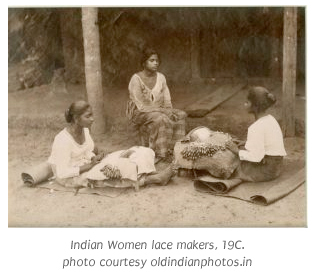 India has always been a place of tremendous creative expression, whether that be articulated through color, cuisine, music, poetry, or fine arts – even though the delicate and intricate patterns of henna (mehndi) application. English lace making was a new art, introduced by missionary Martha Mault in 1821. Her goal in teaching that art was to provide a stream of income to young, lower-caste women who had no other means by which to lift themselves and their families out of poverty. According to Indian author Joy Gnanadason in her book, A Forgotten History, Mault also taught this craft to the slave girls to give them a means to buy back their freedom. She lived James 2:16, “If one of you says to them, “Go in peace; keep warm and well fed,” but does nothing about their physical needs, what good is it?”
India has always been a place of tremendous creative expression, whether that be articulated through color, cuisine, music, poetry, or fine arts – even though the delicate and intricate patterns of henna (mehndi) application. English lace making was a new art, introduced by missionary Martha Mault in 1821. Her goal in teaching that art was to provide a stream of income to young, lower-caste women who had no other means by which to lift themselves and their families out of poverty. According to Indian author Joy Gnanadason in her book, A Forgotten History, Mault also taught this craft to the slave girls to give them a means to buy back their freedom. She lived James 2:16, “If one of you says to them, “Go in peace; keep warm and well fed,” but does nothing about their physical needs, what good is it?”
Martha Mault was from Honiton, an area in East Devon. The Allhallows Museum of Lace in Devon recounts that lace making, which had probably spread from Italy throughout Europe, has been recorded in the area from the 17th century, perhaps earlier. Wives of men who were paid low wages, men who fished or labored for a living, often made the lace as a way to supplement their family’s income. The museum explains that it can take up to five hours to make one square centimeter of lace, perhaps thousands of hours was required for a lace handkerchief or collar.
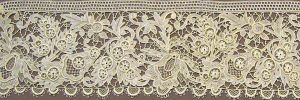
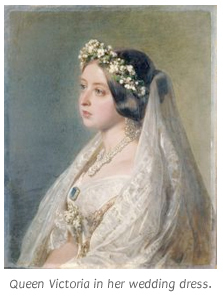 Queen Victoria
Queen Victoria
Honiton lace became very popular indeed when Queen Victoria selected it to adorn her wedding gown; although she was not the first royal to be married in white, she was the most popular, and was married in the age of photography. The tradition of white wedding gowns, adorned with lace, persists to this day.
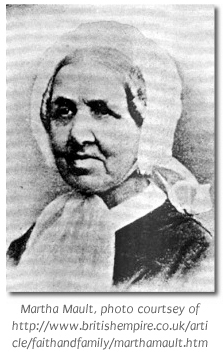 Missionaries
Missionaries
Victorian missionary to India Samuel Mateer recorded that, “Lace-making, introduced by Mrs. Mault in her boarding school at Nagercoil… has succeeded to perfection. Admirable specimens of fine pillow lace, in cotton and gold and silver thread, manufactured at the Mission school, were shown at Madras, and in the great London and Paris Exhibitions, in all of which they gained prize medals… A suggestion has recently been made that it might be more profitable, instead of merely copying and repeating, as has hitherto been done, the old standard English patterns and styles, to get up real Indian designs in accordance with the purest national taste and styles of art, so as to establish the Nagercoil lace as a purely indigenous production.”
Self-Expression
Profitable, as he used it in the era, did not simply mean that it would make more money. It meant beneficial. It was a nod to her progressive nature that Mault encouraged the girls to adapt English methods to their native designs and tastes; they were not to be transformed into English lace-makers but taught to make lace in a manner which could express their own heritage and culture. The Maults and other missionaries networked through the British communities to ensure there was a healthy market for the lace goods.
Gnanadason concludes, “There are thousands of women in their homes doing lace and embroidery as a cottage industry in all the villages of Kanyakumari District and other areas of the old L.M.S. in Nagercoil, Neyyoor, Marthandam, Parasalai, Trivandrum, Attingul, and Quilon. There are established Mission Centers which give out the work, receive them, and pay the women. The proceeds of these have gone into the building of Churches, Schools, Hospitals and Colleges besides supported work among women. The work offers a means to thousands of women who cannot be otherwise employed to subsidize their family income.”
April 15, 2015
Christian Fiction Scavenger Hunt: Stop #16 (Pink Team)
 Welcome to the Christian Fiction Scavenger Hunt! I am a part of TEAM PINK, and this is Stop #16.
Welcome to the Christian Fiction Scavenger Hunt! I am a part of TEAM PINK, and this is Stop #16.
If you’re just joining us, there are two loops—pink and purple—and they begin at Lisa Bergren’s site and Robin Lee Hatcher’s site for stop #1 for either stream. If you complete either the pink loop or purple loop, you can enter for a Kindle paperwhite and the 17 autographed books from that loop. If you complete BOTH loops, you can enter for the Grand Prize of a Kindle Fire HDX and ALL 34 autographed books.
BE SURE to keep track of the clues at the bottom of every post in the loop and the favorite number mentioned. You’ll need those clues to enter for the loop prize and every number mentioned in order to enter for the grand prize. The Hunt begins at NOON Mountain time on April 16 and ends at midnight Mountain on April 19, 2015, so you have a long weekend to complete all 34 stops and maximize your chances at prizes!
ALSO, please don’t use Internet Explorer to navigate through the loops. Some web sites won’t show up using IE. Please use Chrome or Firefox—they’re better anyway!
And now, it’s my pleasure to introduce you to my guest for the Scavenger Hunt, the lovely and talented Deeanne Gist.
NOW FOR THE OFFICIAL BIO:
Deeanne Gist has rocketed up the bestseller lists and captured readers everywhere with her very original, very fun historicals. Add to this four RITA nominations, two consecutive Christy Awards, rave reviews, and a growing loyal fan base, and you’ve got one recipe for success.
AND HERE IS THE SUMMARY OF HER LATEST BOOK:
Tiffany Girl
As preparations for the 1893 World’s Fair set Chicago and the nation on fire, Louis Tiffany—heir to the exclusive Fifth Avenue jewelry empire—seizes the opportunity to unveil his state-of-the-art, stained glass, mosaic chapel, the likes of which the world has never seen.
But when Louis’s dream is threatened by a glassworkers’ strike months before the Fair opens, he turns to an unforeseen source for help: the female students at the New York School of Applied Design. Eager for adventure, the young women pick up their skirts, move to boarding houses, take up steel cutters, and assume new identities as the “Tiffany Girls.”
Tiffany Girl is the heartwarming story of the impetuous Flossie Jayne, a beautiful, budding artist handpicked by Louis to help complete the Tiffany chapel. Though excited to be an independent “New Woman” when most of the fair sex stayed home, she quickly finds the world less welcoming than anticipated. From a Casanova male, to an unconventional married couple, and a condescending singing master, she takes on a colorful cast of characters to transform the boarding house into a home while racing to complete the Tiffany chapel and make a name for herself in the art world.
As challenges mount, her ambitions become threatened from an unexpected quarter: her own heart. Who will claim victory? Her dreams or the captivating boarder next door?
Buy Deeanne Gist’s Book:
Amazon | B&N | CBD
AND NOW HERE IS TIFFANY GIRL’S EXCLUSIVE CONTENT THAT YOU’LL ONLY FIND ON THIS HUNT!
Illustrating History
I’ve always loved the way old hardbacks had images at the beginning of their books—and sometimes at the beginning of every chapter. So with my last three books, I asked the publisher if I could include photographs from the turn-of-the-century at the beginning of each chapter. And they said I could!
With It Happened at the Fair, I included images of the real 1893 Chicago World’s Fair. With Fair Play, I included gripping images from the West Side of Chicago
With my upcoming May release, Tiffany Girl, I interspersed it with real pictures of New York City during the 1890s (the setting of the book), and since the heroine, Flossie Jayne, is an artist, I thought it would be fun to include artwork that Flossie had done. Since Flossie is a fictional character, I hired artist Monica Bruenjes to be “Flossie” for me. So, Tiffany Girl will include original artwork by “Flossie” herself. Isn’t that so fun?
Because I can’t wait for you to see all the images, I decided to give Spring Scavenger Hunt participants an exclusive look at some of my favorites!
THE SCAVENGER HUNT SKINNY:
Thanks for stopping by on the hunt! Before you go, make sure you WRITE DOWN THESE CLUES:
Secret Word(s): “-Helen”
Secret Number: 35, a number I chose, because it’s the number of chapters in Mist of Midnight
Got ‘em down?? Great! Your next stop is #17, Deanne’s site where she’s hosting the wonderful Robin Lee Hatcher. Click here to head on over there now. And if you get lost, a complete list of the loop with links can be found at our mother host’s site.
March 16, 2015
Victorian Gothic Romance Giveaway!
February 14, 2015
Liz Curtis Higgs
“Mist of Midnight is wonderfully atmospheric, with all the right elements for a true Gothic novel, from sounds that go bump in the night to characters who are not at all what they seem. The spiritual underpinning is solid, comforting, even as we’re trapped in the author’s finely spun web of mystery, romance, and a sense of foreboding that doesn’t lift until the final page. Charlotte Brontë? Victoria Holt? Meet Sandra Byrd, the modern mistress of Gothic romance!”
Liz Curtis Higgs, New York Times best-selling author of Mine Is the Night
Death Becomes Her
The Victorians cared very much about how outward appearances reflected inward sentiments and morality. One way they expressed themselves was through mourning clothes and jewelry. Queen Victoria famously wore black from the time of Prince Albert’s death in 1861 till her own death some 40 years later. Mourning regulations were handy social signals to others. Deaths were announced via mourning stationary and sealed with black wax. Sally Mitchell, in Daily Life in Victorian England reminds us that, “Mourning clothes made other people aware of a loss and prevented intrusive personal remarks.”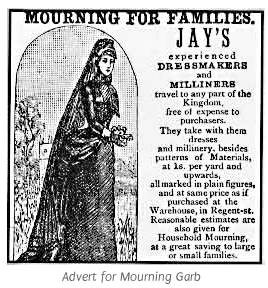 The Business of Mourning
The Business of Mourning
According to Kristine Hughes (The Writer’s Guide to Everyday Life in Regency and Victorian England), early in the century ladies’ magazines “regularly featured fashion plates depicting proper funeral attire, along with articles detailing proper etiquette for the occasion.”
She goes on to tell us that linen drapers shops offered mourning departments. Why? It was big, big business. Who didn’t know someone who had died? Women were limited to the colors black and then grey, but might creatively use different fabrics, textures, and styling to indicate status, wealth, and personal taste. Hughes claims that, “one of the first categories of clothing to be mass-produced was mourning clothes.” Believably so!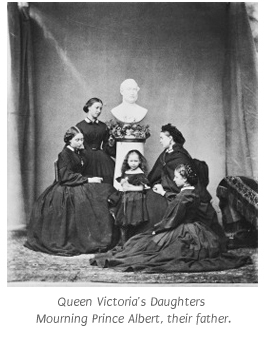 What to Wear
What to Wear
Contrary to the queen’s lengthy example, a widow was expected to mourn her husband for only two years – most people didn’t live as long as Victoria, and there was little time to waste. Mitchell reminds us that the widow, “could moderate her funereal clothing a bit after a while to ‘half-mourning,’ which consisted of pinstripe black.” Later this also included grays, especially for the younger generation.
Mitchell continues, “During the first year of mourning, widows were to conduct themselves as veritable social outcasts, forced to refuse all invitations, the only visits permitted being to close relatives or church services, including weddings and christenings.” The parent or a child of the deceased was expected to mourn for a shorter period of time: Twelve months in whole, which eventually moved in color from black, to grey before the full color spectrum was allowed along with full engagement in social activities. Siblings mourned for six months.
Funerals
Unless the death was a suicide, funerals usually took place in the morning. Mitchell says, “Among the gentry and prosperous middle classes, the coach was draped in black velvet and the horses wore black plumes,” and, “Male friends or hired mourners called mutes walked alongside. Sometimes they carried the heavy black pall that was draped over the coffin. Everyone attending the funeral wore black garments made of wool and crepe. Men wore black gloves; flowing bands of black cloth known as weepers were tied around their hats. Even among the poorest, it was important for immediate relatives to wear black clothing.”
No family? Few friends? No problem. Mourners would be hired. In fact, the British newspaper The Daily Express newspaper tells us that mutes, “looked tragic during the service and doubled as waiters for the wake. Dickens despised them and in the funeral in Martin Chuzzlewit he describes: ‘Two mutes… looking as mournful as could reasonably be expected of men with such a thriving job in hand.'”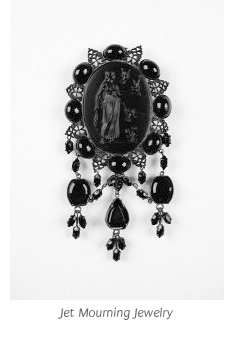 Black Baubles
Black Baubles
One of the most fascinating, and perhaps creepy, aspect of Victorian mourning was the jewelry it inspired.
Items made of jet grew popular after the Queen wore it upon the death of Prince Albert, a custom she did not abandon clear to her own death in 1901. According to Hughes, “Jet jewelry has been associated with mourning for some time, though it was not mass-produced before the early 19th century. Jet is made from the fossilized driftwood of the monkey puzzle tree and is also found in the form of slate.” Mitchell adds,” Very close relatives might wear a brooch or watch-fob woven from the dead person’s hair.”
Yes, hair.
Hughes tells us that, “Jewelry made from the hair of the deceased was popular from 1790 to 1840, and this, too, was incorporated into mourning jewelry, being given settings of black or white enamel, jet with gold, and often embellished with the words ‘In Memoriam.'”
Sometimes they would take a tooth from a deceased and mount it in a ring or a necklace. They didn’t eat much sugar then so contrary to current opinion, their teeth were pretty good. Just, perhaps, not pretty in the finger.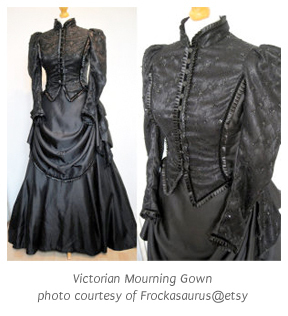
Memento Mori
vMemento Mori is Latin for, Remember… you have to die. During the early days of photography, the Victorians would take pictures of the recently deceased in their homes, gardens, or even beds, posed doing something they would have done while alive. Perhaps it was a macabre way to remind the survivors to think of the fleetingness of life, and to number their days. The oddest, most morbid photos included babies who had passed away settled neatly into their prams.
What’s Old Is New Again
It’s true that there is nothing under the sun, and mourning is big business again. Black still predominates, and while pictures of those passed are not popular, The Daily Express reports that, “Rent A Mourner, an Essex-based company providing sad people for funerals when (as its website delicately puts it) ‘here may be a low turnout expected’. Bookings are also on the up because people want something more dramatic than a mousey British send-off. They want sobbing, hair tearing and breast beating, in the way of excitable foreigners.”
Perhaps this is an answer to temporary job needs. As Assistant Editor Jennifer Selway puts it, “Yes, a career in professional mourning could be the answer. Short hours, free booze and all the ham sandwiches you can eat.”



